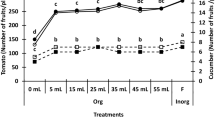Abstract
A study of fertilization practices in intensively grown tomatoes, leading to a projection of developments in fertilizer usage is presented. Targets of optimal fertilization strategy were defined as follows: maximize fruit yield; maximize fruit quality; minimize environmental pollution with fertilizers; minimize corrosion of the fertilizer distribution system; minimize expenses on fertilizers. Information was gathered by literature searches and by personal interviews and visits to research institutes and growers.
Rechecking of some fertilization practices for greenhouse tomatoes grown in detached media is proposed. The review indicates that the following should be rechecked: ammonium/nitrate ratio in fertilizer formulations; use of urea in fertilizer solutions; levels of phosphates applied; levels of sulphate applied; simple iron salts vs. chelated iron application; osmotic potential (OP), expressed as electrical conductivity (EC), of the nutrient solution at various growth stages.
EC, pH and estimated prices of fertilizer solutions were calculated and presented in tables.
Similar content being viewed by others
References
Adams P (1989) Some responses of tomatoes grown in NFT to sodium chloride. Proc. 7th Intern. Congress on Soilless Culture, 59–71
Aendekerk GL (1977) Fertilizer application in greenhouses by way of sprinkling irrigation. Consulentschap voor de Tuinbouw, Boskoop, Netherlands. Bedrijfsontwikkeling 8: 99–104
Ajayi O, Maynard DN and Barker AV (1970) The effect of potassium on ammonium nutrition of tomato (Lycopersicon esculentum Mill.). Agron J 62: 818–821
Bar-Yosef B, Sagiv B and Eliah E (1980) Fertilization and irrigation of winter tomatoes grown in glasshouse in the Besor area. Prelim. Rep. Div. Sci. Publ. Bet Dagan (775): 90 pp
Dibb DW and Welch LF (1976) Corn growth as affected by ammonium vs. nitrate absorbed from soil. Agron J 68: 89–94
Gibson CJ and Pill WG (1983) Effects of preplant phosphorus fertilization rate and of nitrate and ammonium liquid feeds on tomato grown in peat-vermiculite. J Am Soc Hort Sci 108: 1007–1011
Hageman RH (1984) Ammonium versus nitrate nutrition of higher plants. In Hauck RD (ed) Nitrogen in Crop Production. pp. 67–85. Amer Soc Agro, Madison WI
Hagin J and Olsen SR (1990) Nitrogen nutrition of corn supplied with ammonium-nitrate mixtures, and potassium. Agrochimica (to be published)
Huett DO and Dettmann EB (1988) Effect of nitrogen on growth, fruit quality and nutrient uptake of tomatoes grown in sand culture. Austral J Exper Agric 28: 391–399
Israeli Y, Katz S and Hagin J (1985) Efficiency of fertilizers as nitrogen sources to banana plantations under drip irrigation. Fertil Res 8: 101–106
Kondo T (1972) Supplying fertilizer solution for tomato plants. Bul Hort Res Sta, B (Okitsu) (No. 12): 181–206
Marschner H (1986) Mineral Nutrition of Higher Plants. Academic Press, pp 674
Mizrahi Y et al (1988) A saline irrigation regime for improving tomato fruit quality without reducing yield. J Am Soc Hort Sci 113: 202–205
Muller-Haslach W, Arold G and Kimmel V (1986) Effect of nutrient intensity on the quality of tomatoes. Bayer Landwirt Jahrb Sonderh 63 (1): 81–104
Papadopoulos I (1987) Nitrogen fertigation of greenhouse-grown tomato. Commun Soil Sci Plant Anal 18: 897–907
Olsen SR (1986) The role of organic matter and ammonium in producing high corn yields. In Chen Y and Avnimelech Y (eds.) The Role of Organic Matter in Modern Agriculture. pp. 29–54. Martinus Nijhoff Publ
Shaviv A, Hagin J and Neumann PM (1987) Effects of nitrification inhibitor on efficiency of nitrogen utilization by wheat and millet. Commun Soil Sci Plant Anal 18: 815–833
Shaviv A and Hagin J (1988) Interaction of ammonium and nitrate nutrition with potassium in wheat. Fertil Res 17: 137–146
Smith DL (1987) Rockwool in Horticulture. Grower Books, London, p 108
Sonneveld C and van der Wees A (1988) Voedingsoplossingen voor teelten in steenwol in het Westland en de Kring. Proefstation voor Tuinbouw onder Glas te Naaldwijk, pp 31
Sonneveld C and Welles GWH (1988) Yield and quality of rockwool-grown tomatoes as affected by variation in EC-value and climatic conditions. Plant and Soil 111: 37–42
Sposito G and Mattigod SV (1980) Geochem: A computer program for the calculation of chemical equilibria in soil solutions and other natural water systems. Dept Soil and Envir Sci, Univ Calif, Riverside pp 92
Tsikalas PE and Manios VI (1984) Tomato nutrition in growing-bags in greenhouse. I. Effect on the yield. Proc 3rd Conf Protected Vegetables and Flowers
Tsikalas PE and Manios VI (1985) Nutrition of tomatoes in growing-bags in greenhouse. I. Effect on productivity. Georgike Ereuna 9 (2): 279–289
Winsor GW (1984) Diagnosis of the nutritional status of protected crops. Acta Hortic 145: 236–250
Winsor GW and Adams P (1987) Diagnosis of mineral disorders in plants. Glasshouse crops. Vol 3. Her Majesty's Stationary Office 168 pp
Author information
Authors and Affiliations
Rights and permissions
About this article
Cite this article
Hagin, J., Segelman, G. & Shaviv, A. Strategy for development of fertilizer solutions for greenhouse tomatoes. Fertilizer Research 26, 53–60 (1990). https://doi.org/10.1007/BF01048743
Issue Date:
DOI: https://doi.org/10.1007/BF01048743



